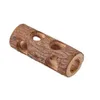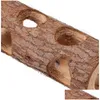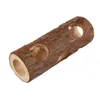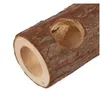For wooden chicken coop consumers, planning and materials are essential for a long-lasting structure. A budget-friendly plan should consider flock size, climate, and other variables. Building techniques vary from pre-made panels to scratch building, while design options balance functionality with style by incorporating features such as windows, ventilation, and nesting boxes. Tips on repurposing old materials or buying in bulk can help save money on supplies. Cost-effective alternatives such as using hardware cloth instead of welded wire mesh can also be utilized. Regular maintenance and upkeep is vital to prevent wear and tear. Best practices for chicken care include proper nutrition, hydration, and protection from predators and disease.








The Importance of Planning and Materials
Planning is an essential aspect of any construction project, including building a chicken coop. A solid plan should consider the size of your flock, the climate in your area, and other variables such as predators, zoning regulations, and the terrain of your land. Having a detailed plan will ensure that your coop is sturdy, functional, and comfortable for your chickens.
When creating a budget-friendly plan, you should first determine the size of your flock. For example, if you have ten chickens, you will need a coop that is at least 40 square feet in size. You should also ensure that your coop has enough ventilation, insulation, and natural light. This will help to regulate the temperature inside the coop and keep your chickens healthy.
Another factor to consider when planning your wooden chicken coop is the climate in your area. If you live in an area with harsh winters, you will need to insulate your coop to protect your chickens from frostbite. On the other hand, if you live in a hot and humid climate, you will need to provide adequate ventilation to prevent heat stress.
The next crucial aspect of building a wooden chicken coop is choosing the right materials. The materials you use will affect the durability, safety, and comfort of your coop. When choosing materials, you should opt for those that are sturdy, weather-resistant, and easy to clean.
One of the most popular materials for building chicken coops is wood. It is affordable, easy to work with, and provides excellent insulation. However, you should ensure that you choose high-quality lumber that is free from knots and cracks. You can also consider using pressure-treated or rot-resistant wood to increase the longevity of your coop.
Other materials that you may need include hardware cloth, roofing materials, and nesting boxes. Hardware cloth is essential for protecting your chickens from predators such as raccoons and foxes. Roofing materials such as metal or asphalt shingles will protect your coop from rain and snow. Nesting boxes provide a comfortable and private space for your chickens to lay their eggs.
Building Techniques and Design Options
One of the most popular building techniques for wooden chicken coops is using pre-made panels. These panels are usually made of high-quality wood and come in various sizes and shapes. They are easy to assemble and require minimal construction knowledge. This method is ideal for those who want a quick and easy solution to housing their chickens. However, pre-made panels may not be the best option for those who want complete control over the design and customization of their coop.
For those who prefer to build their own coop from scratch, there are several design options available to balance functionality with style. One important functional component is ventilation. Proper air circulation can prevent respiratory problems in your chickens. Adequate ventilation can be achieved by adding windows or vents to your coop design.
Another essential aspect of a functional coop is nesting boxes. Chickens need a safe and comfortable place to lay their eggs. Nesting boxes should be located in an area that is protected from predators and the elements. They should also be easily accessible for egg collection.
In addition to functionality, the style of your chicken coop can be customized to fit your preferences. Adding decorative elements such as color, shape, and trim can give your coop a unique look. Some consumers even go above and beyond by incorporating themes such as a rustic farmhouse or a beach cottage into their coop design.
Saving Money on Supplies
One way to save money on supplies is to repurpose old materials. For example, if you have an old shed or playhouse that is no longer in use, you can repurpose the wood to build a chicken coop. This not only saves money but is also a sustainable option since it reduces waste. Additionally, if you have any leftover scrap wood from previous projects, you can use this to build nesting boxes or perches inside the coop.
Another way to save money is to buy in bulk. Many hardware stores offer discounts for buying items in large quantities. If you know exactly what supplies you’ll need for your chicken coop, consider purchasing them all at once to take advantage of bulk pricing. This can include items such as screws, nails, and insulation.
When it comes to choosing materials, there are cost-effective alternatives to expensive options. For example, instead of using welded wire mesh for the chicken run, consider using hardware cloth. While welded wire mesh may be more durable, hardware cloth is cheaper and still provides adequate protection for your flock. Similarly, using corrugated plastic roofing instead of metal roofing can save you money without sacrificing quality.
Maintenance and Upkeep
Regular maintenance is crucial for keeping a wooden chicken coop in good condition. By regularly cleaning the coop, you can remove built-up debris, feces, and other potential sources of bacteria and parasites that could harm your chickens. Additionally, regular cleaning can help prevent the wood from rotting and keep the coop looking neat and tidy. It’s also important to inspect the coop for any signs of damage or wear and tear, as catching these issues early can prevent them from becoming more significant problems down the line.
When it comes to cleaning a wooden chicken coop, start by removing all of the chickens and their bedding. Use a shovel or rake to remove any built-up manure and soiled bedding from the floor of the coop. Then, use a mild detergent and warm water to scrub the interior surfaces of the coop, including the walls, nesting boxes, and perches. Rinse thoroughly with clean water and allow the coop to air dry before adding fresh bedding and allowing the chickens back inside.
In addition to regular cleaning, it’s essential to repair and reinforce the coop as needed to prevent wear and tear. Check the coop for any loose or damaged boards, nails, or hardware, and make repairs as necessary. Pay close attention to areas where the wood may be starting to rot or show signs of insect damage, as these areas will need to be addressed promptly to prevent further deterioration. Reinforcing the coop with additional braces or supports can also help extend its lifespan and prevent damage from heavy winds or other environmental factors.
Best Practices for Chicken Care
Feeding
Chickens need a balanced diet to maintain their health and produce eggs. Commercial feed is available at most farm supply stores and should be the mainstay of your chickens’ diet. However, supplementing their diet with fresh fruits, vegetables, and grains can provide additional nutrition and keep them happy. It’s important to ensure that their feeders are always clean and filled with fresh food to avoid contamination or spoilage.
Watering
Chickens require access to clean water at all times. A reliable source of freshwater should be readily available in your coop or nearby. Waterers should be cleaned frequently to prevent the buildup of harmful bacteria. Additionally, during colder months, it’s important to make sure that the water doesn’t freeze over.
Protection
Predators such as foxes, raccoons, and coyotes are common threats to backyard flocks. To protect your chickens, ensure that your coop is secure and free of any potential entry points. Wire mesh should be used to enclose the coop and cover any windows or ventilation openings. Additionally, consider using motion-activated lights or alarms to deter predators.
Disease prevention
Diseases can spread quickly among chickens if they aren’t properly managed. To prevent disease, ensure that your coop is kept clean and dry. Spilled feed and water should be promptly cleaned up to reduce the risk of bacterial growth. Regularly inspect your chickens for signs of illness and isolate any sick birds to prevent the spread of disease.
In conclusion, proper chicken care involves more than just a sturdy and stylish coop. By following these best practices for feeding, watering, and protection, you can ensure that your flock remains healthy and happy. With a little bit of effort, you can enjoy the many benefits of raising chickens.
FAQ
Q1. What materials are needed to build a wooden chicken coop on a budget?
To build a sturdy and stylish wooden chicken coop on a budget, you’ll need pressure-treated lumber, exterior-grade plywood, galvanized nails, screws, hinges, roofing material, and hardware cloth. You can also use recycled or repurposed materials, such as old fence boards or pallets, to cut down on costs even further.
Q2. How much space do my chickens need in their coop?
It’s recommended to provide at least 4 square feet of indoor space per chicken, and 10 square feet of outdoor space in a run. However, if you have larger breed chickens, you’ll need to allow for more space. It’s important to remember that crowded conditions can lead to stress, fighting, and disease among your flock.
Q3. How can I keep my chicken coop predator-proof?
Predators such as raccoons, foxes, and coyotes are a constant threat to backyard flocks. To keep your chickens safe, make sure to use sturdy hardware cloth instead of chicken wire for all openings in the coop and run. Use latches and locks on all doors and windows to prevent predators from gaining access. You can also install motion-activated lights and alarms to deter nighttime predators.
Q4. What kind of bedding should I use in my chicken coop?
There are several options for chicken coop bedding, including straw, wood shavings, and sand. Each has its advantages and disadvantages. Straw is cheap and easy to find, but can become moldy and attract pests. Wood shavings are absorbent and reduce odors, but can be dusty and cause respiratory issues for your chickens. Sand is easy to clean and prevents moisture buildup, but can be heavy to move and doesn’t provide much insulation in colder months. Choose the bedding that best fits your needs and budget.

